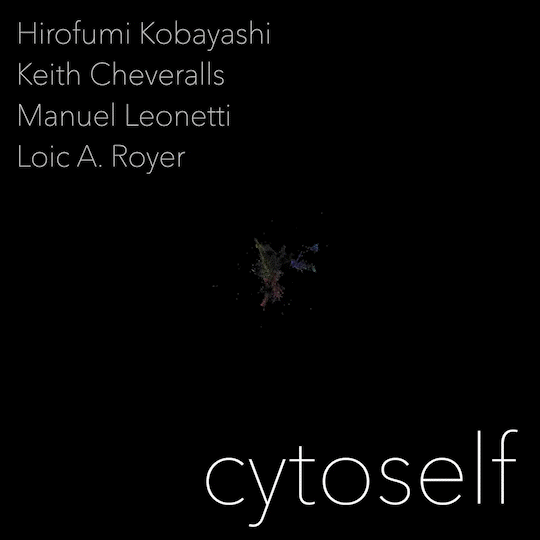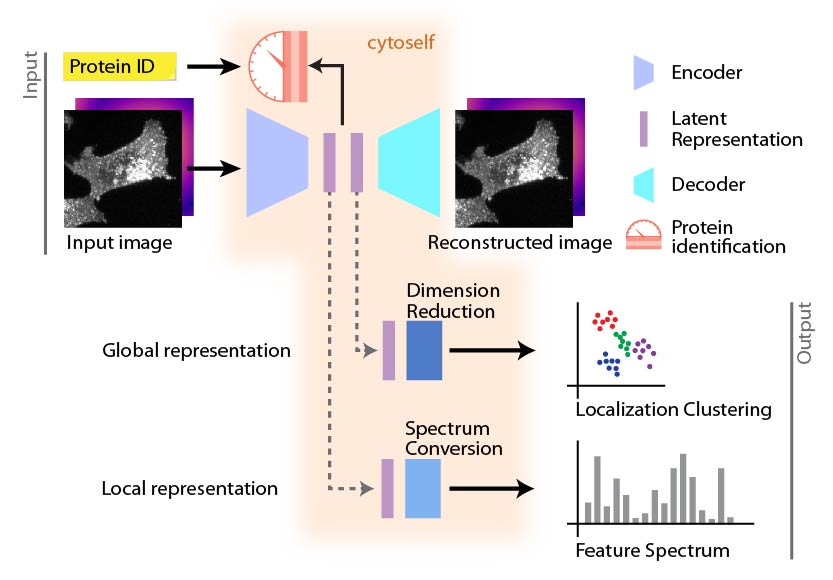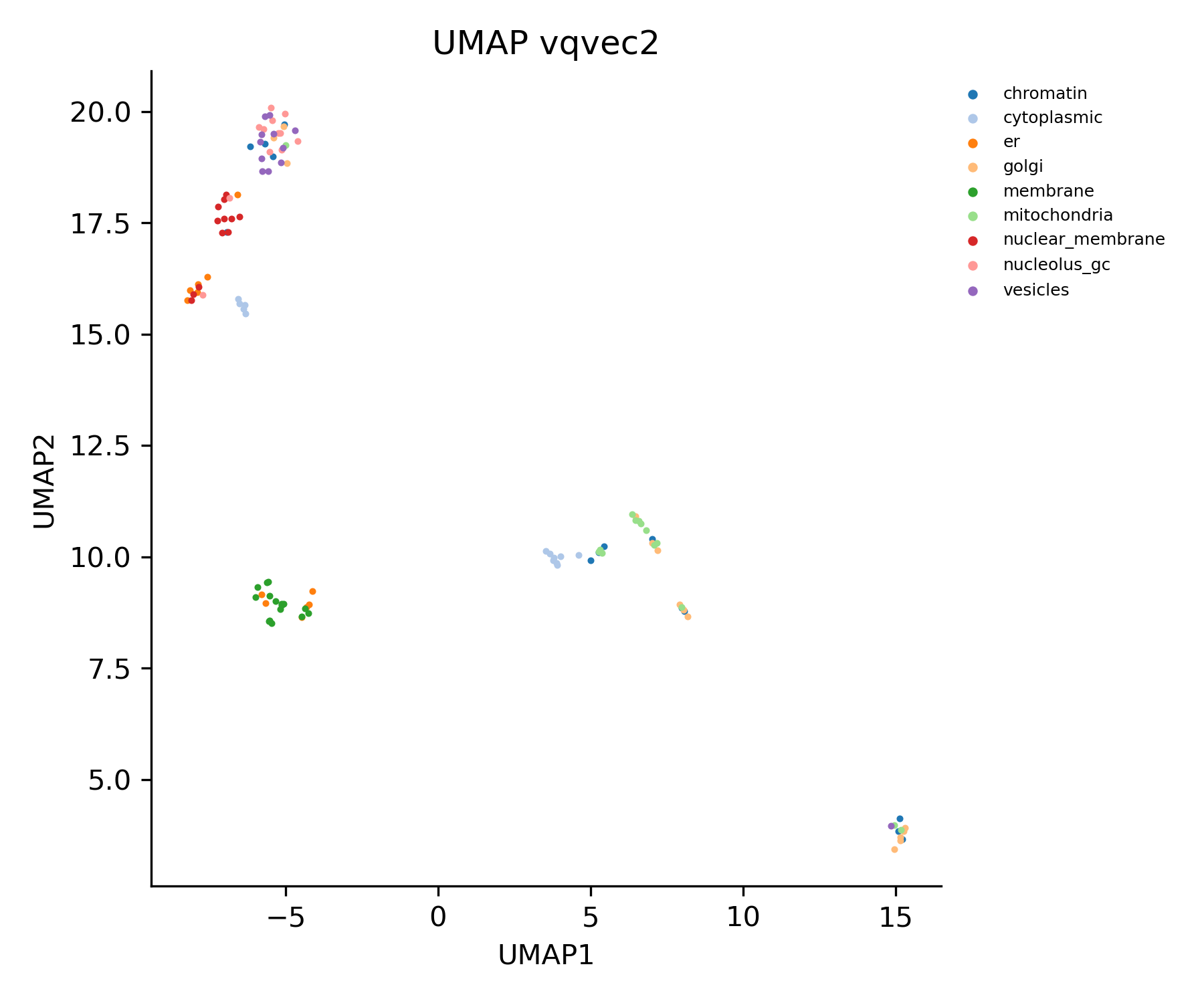cytoself in pytorch implementation. The original cytoself implemented in tensorflow is archived in the branch cytoself-tensorflow.
Note: Branch names have been changed. cytoself-pytorch -> main, the previous main -> cytoself-tensorflow.
cytoself is a self-supervised platform for learning features of protein subcellular localization from microscopy images [1]. The representations derived from cytoself encapsulate highly specific features that can derive functional insights for proteins on the sole basis of their localization.
Applying cytoself to images of endogenously labeled proteins from the recently released OpenCell database creates a highly resolved protein localization atlas [2].
[1] Kobayashi, Hirofumi, et al. "Self-Supervised Deep-Learning Encodes High-Resolution Features of Protein
Subcellular Localization." Nature Methods (2022).
https://www.nature.com/articles/s41592-022-01541-z
[2] Cho, Nathan H., et al. "OpenCell: Endogenous tagging for the cartography of human cellular organization."
Science 375.6585 (2022): eabi6983.
https://www.science.org/doi/10.1126/science.abi6983
cytoself uses images (cell images where only single type of protein is fluorescently labeled) and its identity information (protein ID) as a label to learn the localization patterns of proteins.
Recommended: create a new environment and install cytoself on the environment from pypi
(Optional) To run cytoself on GPUs, it is recommended to install pytorch GPU version before installing cytoself following the official instruction. The way to install pytorch GPU may vary upon your OS and CUDA version.
conda create -y -n cytoself python=3.9
conda activate cytoself
# (Optional: Install pytorch GPU following the official instruction)
pip install -e .Install development dependencies
pip install -r requirements/development.txt
pre-commit installDownload one set of the image and label data from Data Availability.
is available.
from cytoself.datamanager.opencell import DataManagerOpenCell
data_ch = ['pro', 'nuc']
datapath = 'sample_data' # path to download sample data
DataManagerOpenCell.download_sample_data(datapath) # donwload data
datamanager = DataManagerOpenCell(datapath, data_ch, fov_col=None)
datamanager.const_dataloader(batch_size=32, label_name_position=1)A folder, sample_data, will be created and sample data will be downloaded to this folder.
The sample_data folder will be created in the "current working directory," which is where you are running the code.
Use os.getcwd() to check where the current working directory is.
9 sets of data with 4 files for each protein (in total 36 files) will be downloaded.
The file name is in the form of <protein_name>_<channel or label>.npy.
*_label.npyfile: Contains label information in 3 columns, i.e. Ensembl ID, protein name and localization.*_pro.npyfile: Image data of protein channel. Size 100x100. Images were cropped with nucleus being centered (see details in paper).*_nuc.npyfile: Image data of nucleus channel. Size 100x100. Images were cropped with nucleus being centered (see details in paper).*_nucdist.npyfile: Data of nucleus distance map. Size 100x100. Images were cropped with nucleus being centered (see details in paper).
from cytoself.trainer.cytoselflite_trainer import CytoselfFullTrainer
model_args = {
'input_shape': (2, 100, 100),
'emb_shapes': ((25, 25), (4, 4)),
'output_shape': (2, 100, 100),
'fc_output_idx': [2],
'vq_args': {'num_embeddings': 512, 'embedding_dim': 64},
'num_class': len(datamanager.unique_labels),
'fc_input_type': 'vqvec',
}
train_args = {
'lr': 1e-3,
'max_epoch': 1,
'reducelr_patience': 3,
'reducelr_increment': 0.1,
'earlystop_patience': 6,
}
trainer = CytoselfFullTrainer(train_args, homepath='demo_output', model_args=model_args)
trainer.fit(datamanager, tensorboard_path='tb_logs')from cytoself.analysis.analysis_opencell import AnalysisOpenCell
analysis = AnalysisOpenCell(datamanager, trainer)
umap_data = analysis.plot_umap_of_embedding_vector(
data_loader=datamanager.test_loader,
group_col=2,
output_layer=f'{model_args["fc_input_type"]}2',
title=f'UMAP {model_args["fc_input_type"]}2',
xlabel='UMAP1',
ylabel='UMAP2',
s=0.3,
alpha=0.5,
show_legend=True,
)The output UMAP plot will be saved at demo_output/analysis/umap_figures/UMAP_vqvec2.png by default.
# Compute bi-clustering heatmap
analysis.plot_clustermap(num_workers=4)
# Prepare image data
img = next(iter(datamanager.test_loader))['image'].detach().cpu().numpy()[:1]
# Compute index histogram
vqindhist1 = trainer.infer_embeddings(img, 'vqindhist1')
# Reorder the index histogram according to the bi-clustering heatmap
ft_spectrum = analysis.compute_feature_spectrum(vqindhist1)
# Generate a plot
import numpy as np
import matplotlib.pyplot as plt
x_max = ft_spectrum.shape[1] + 1
x_ticks = np.arange(0, x_max, 50)
fig, ax = plt.subplots(figsize=(10, 3))
ax.stairs(ft_spectrum[0], np.arange(x_max), fill=True)
ax.spines[['right', 'top']].set_visible(False)
ax.set_xlabel('Feature index')
ax.set_ylabel('Counts')
ax.set_xlim([0, x_max])
ax.set_xticks(x_ticks, analysis.feature_spectrum_indices[x_ticks])
fig.tight_layout()
fig.show()Rocky Linux 8.6, NVIDIA A100, CUDA 11.7 (GPU)
Ubuntu 20.04.3 LTS, NVIDIA 3090, CUDA 11.4 (GPU)
Ubuntu 22.04.3 LTS, NVIDIA 4090, CUDA 12.2 (GPU)
There seems to be compatibility issues of python multiprocessing on Windows, causing a DataLoader unable to load data (issue, issue). Please try the temporal workaround.
The full data used in this work can be found here.
The image data have the shape of [batch, 100, 100, 4], in which the last channel dimension corresponds to [target protein, nucleus, nuclear distance, nuclear segmentation].
Due to the large size, the whole data is split to 10 files. The files are intended to be concatenated together to form one large numpy file or one large csv.
Image_data00.npy
Image_data01.npy
Image_data02.npy
Image_data03.npy
Image_data04.npy
Image_data05.npy
Image_data06.npy
Image_data07.npy
Image_data08.npy
Image_data09.npy
Label_data00.csv
Label_data01.csv
Label_data02.csv
Label_data03.csv
Label_data04.csv
Label_data05.csv
Label_data06.csv
Label_data07.csv
Label_data08.csv
Label_data09.csv






